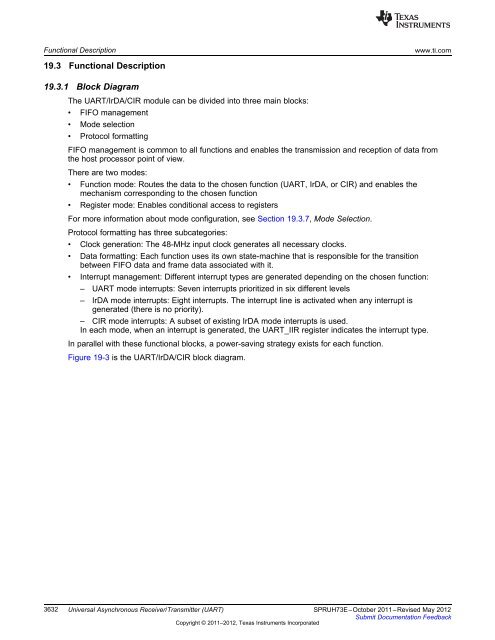Chapter 19 Universal Asynchronous Receiver-Transmitter (UART).pdf
Chapter 19 Universal Asynchronous Receiver-Transmitter (UART).pdf
Chapter 19 Universal Asynchronous Receiver-Transmitter (UART).pdf
Create successful ePaper yourself
Turn your PDF publications into a flip-book with our unique Google optimized e-Paper software.
Functional Description www.ti.com<br />
<strong>19</strong>.3 Functional Description<br />
<strong>19</strong>.3.1 Block Diagram<br />
The <strong>UART</strong>/IrDA/CIR module can be divided into three main blocks:<br />
• FIFO management<br />
• Mode selection<br />
• Protocol formatting<br />
FIFO management is common to all functions and enables the transmission and reception of data from<br />
the host processor point of view.<br />
There are two modes:<br />
• Function mode: Routes the data to the chosen function (<strong>UART</strong>, IrDA, or CIR) and enables the<br />
mechanism corresponding to the chosen function<br />
• Register mode: Enables conditional access to registers<br />
For more information about mode configuration, see Section <strong>19</strong>.3.7, Mode Selection.<br />
Protocol formatting has three subcategories:<br />
• Clock generation: The 48-MHz input clock generates all necessary clocks.<br />
• Data formatting: Each function uses its own state-machine that is responsible for the transition<br />
between FIFO data and frame data associated with it.<br />
• Interrupt management: Different interrupt types are generated depending on the chosen function:<br />
– <strong>UART</strong> mode interrupts: Seven interrupts prioritized in six different levels<br />
– IrDA mode interrupts: Eight interrupts. The interrupt line is activated when any interrupt is<br />
generated (there is no priority).<br />
– CIR mode interrupts: A subset of existing IrDA mode interrupts is used.<br />
In each mode, when an interrupt is generated, the <strong>UART</strong>_IIR register indicates the interrupt type.<br />
In parallel with these functional blocks, a power-saving strategy exists for each function.<br />
Figure <strong>19</strong>-3 is the <strong>UART</strong>/IrDA/CIR block diagram.<br />
3632 <strong>Universal</strong> <strong>Asynchronous</strong> <strong>Receiver</strong>/<strong>Transmitter</strong> (<strong>UART</strong>) SPRUH73E–October 2011–Revised May 2012<br />
Submit Documentation Feedback<br />
Copyright © 2011–2012, Texas Instruments Incorporated
















